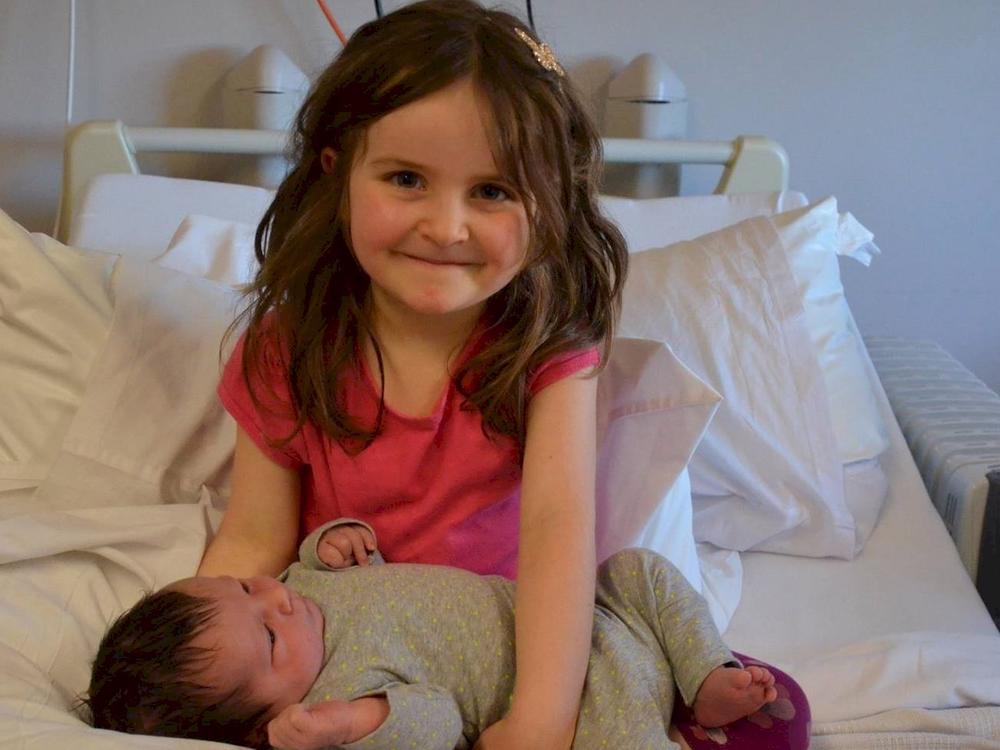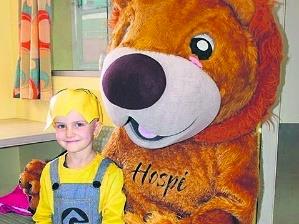Support Saoirse and family
A page to help support Saoirse and her family. Little 5-year-old Saoirse has been diagnosed with stage 5 cancer.
Wellington
A recent MRI revealed that the tumor on Saoirse's left kidney is in stage 5, which is inoperable. The kidney cannot be saved. However, the right kidney has four small tumors and the goal is to reduce these in order to save the kidney.
Recently, lung tumors have been found and these are now a growing cause for concern.
There is treatment available and this is what we need your help for. The treatment itself should be spread over 8 months minimum. The treatment will involve 6 weeks of chemotherapy in Christchurch, after which Saoirse will receive a scan to see if an operation is possible. After that, she will again receive chemotherapy and radiotherapy.
Saoirse is such an amazing little girl and super bright, which in this case has made it so much sadder as she knows what is going on and is so scared!
The family is looking like they could be staying in Christchurch for up to 9 months for Saoirse's treatment. We all know the daily struggles all families have, but add into the mix of being away from home for that long, and wanting to stay by your baby's side the whole way — it is all a huge financial burden.
Imagine if we could take away this stress and allow Mummy, Daddy and baby brother to put all of their energy into little Saoirse without having to worry about anything else.
Every little bit helps. This is Saoirse's time of need, and you can make a big difference with a small donation.
James Wood's involvement (page creator)
Like you, we are friends wanting to help.
Other page links
Latest update
More info on Wilms Tumors 24 May 2016
Most parents can't think of anything more frightening than being told their child has cancer. Fortunately, most kids with Wilms tumor, a rare kidney cancer, survive and go on to live normal, healthy lives due to the highly treatable nature of the disease.
Also known as nephroblastoma, Wilms tumor can affect both kidneys ? but usually develops in just one. Doctors believe that the tumor begins to grow as a fetus develops in the womb, with some cells that are destined to form into the kidneys malfunctioning and forming a tumor.
Signs and Symptoms
Before being diagnosed with Wilms tumor, most children do not show any signs of having cancer, and usually act and play normally. Often, a parent may discover a firm, smooth lump in the child's abdomen. It is not uncommon for the mass to grow quite large before it is discovered ? the average Wilms tumor is 1 pound at diagnosis.
Some children also may have nausea, stomach pain, high blood pressure (hypertension), blood in the urine, loss of appetite, or fever.
Even though Wilms tumors often are large when found, most have not spread to other areas of the body. This makes it easier to successfully treat than if the cancer cells have spread (metastasized) to other parts of the body.
Diagnosis
Several tests are used to confirm a Wilms tumor diagnosis and determine the stage of the disease. Tests that might be used include:
Ultrasonography (ultrasound or US), usually the first tool used to diagnose the condition, uses sound waves instead of X-rays to generate an image of the area doctors wish to view.
Computed tomography (CT or CAT scan) produces a detailed cross-sectional view of an organ through X-rays. It is extremely useful in detecting tumors and determining whether cancer has spread to other areas.
Magnetic resonance imaging (MRI) uses radio waves and strong magnets to produce detailed pictures of the internal parts of the body. This provides more intricate images that allow doctors to see if the cancer has invaded any major blood vessels near the kidney.
X-rays are used to look for any metastasized areas, especially in the lungs.
Bone scans use small amounts of radioactive material to highlight areas of diseased bone, if any exist.
Laboratory tests such as blood tests and urinalysis check the general health of a patient and to detect any adverse side effects (such as low red or white blood cell counts) of the treatment.
The chance of Wilms tumor being hereditary ("running in the family") is so rare that there is no test to screen those who may pass the disease onto their offspring. However, certain genetic factors like birth defect syndromes can increase the likelihood of developing the disease. Those with a family history or personal history of Beckwith-Wiedemann syndrome (a condition associated with larger-than-normal internal organs), WAGR (marked by defects of the iris, kidneys, urinary tract, or genitalia), or Denys-Drash syndrome (a defect of the genitalia) are at risk.
Kids with risk factors for Wilms tumor should be screened for the disease through an ultrasound every 3 months until about age 6 or 7. Those at high risk may get undergo screening until they're a little older.
Treatment
Treatment is determined by many factors, the most important being the stage of the cancer at diagnosis, and the condition, or histology, of the cancer cells when observed under a microscope. "Favorable" histology is associated with a good chance of a cure; tumors with "unfavorable" histology are more aggressive and difficult to cure. About 95% of Wilms tumors have favorable histology.
Doctors use a staging system to describe the extent of a metastasized tumor. It is extremely useful in determining prognosis (possibility for a cure) and the best course of treatment. For example, a child with very aggressive disease should be given an intensive regimen of medication to achieve the best chance for a cure. A child with less-invasive disease should be given the least amount needed to reduce long-term side effects from toxicity.
The stages are:
Stage I: Cancer is found in one kidney only and can be completely removed by surgery. About 41% of all Wilms tumors are stage I.
Stage II: Cancer has spread beyond the kidney to the surrounding area, but can be completely removed by surgery. About 23% are stage II.
Stage III: Cancer has not spread beyond the abdomen, but cannot be completely removed by surgery. About 23% are stage III.
Stage IV: Cancer has spread to distant parts of the body; most commonly, the lungs, liver, bone, and/or brain. About 10% are stage IV.
Stage V: Cancer is found in both kidneys at diagnosis (also called bilateral tumors). About 5% are stage V.
Surgery is most often used to treat Wilms tumor. For stages I through IV, a radical nephrectomy ? removal of the cancer along with the entire kidney, ureter (tube that carries urine from the kidney to the bladder), adrenal gland (hormone-producing gland that sits on top of the kidney), and surrounding fatty tissue ? is done.
Since stage V patients have cancer involvement in both kidneys, removing both kidneys would result in kidney failure and the need for a kidney transplant. As a result, surgeons usually take out as much of the cancer as possible and preserve as much healthy kidney tissue as they can to avoid an organ transplant.
Regardless of the stage and histology, all treatment plans usually include both surgery and chemotherapy, and the more advanced stages also may require radiation therapy. Chemotherapy uses drugs (administered either orally or intravenously) to enter the bloodstream, circulate throughout the body, and kill cancerous cells wherever they may be. Radiation uses high-energy X-ray beams to kill specific cells in different areas of the body.
Both treatments have short-term and long-term risks. Temporary or short-term discomfort may include nausea and vomiting, loss of appetite, mouth sores, fatigue, loss of hair, weakened immune system (leaving a patient vulnerable to infection), and bleeding or bruising.
Long-term effects may include the development of secondary cancers (like leukemia) or the weakening of some internal organs, such as the heart. However, these risks are minimal ? the benefits of treatment far outweighs potential risks.
Caring for Your Child
As much as parents long to have their child out of the hospital, they often feel unsure of whether they can provide appropriate care after their child comes home. The doctors, nurses, and home health services should provide all the information and support needed to help a parent care for a child between hospital visits.
Depending on the treatment regimen (and a child's general health and the doctor's recommendations), appropriate at-home care can vary. Treatment for most children with Wilms tumor is not as intensive as treatment for other cancers (except for more advanced stages) so most kids won't have tremendous restrictions on them.
Most kids undergoing treatment for Wilms don't have special nutritional requirements or need medication for low blood cell counts, as most other cancer patients do. However, parents must watch for signs of distress, like fever, nausea, vomiting, or diarrhea. A child with a high fever should see a doctor right away.
Once a child is finished with therapy, the care team will provide a schedule of follow-up tests. Chest X-rays or CT scans may be taken every several months. Stage and histology of the cancer will determine the ultrasound schedule. Blood work and a physical exam may be required to check for adverse effects of the treatment.
For kids who relapse (the cancer returns), prognosis and treatment depend on their prior therapy, the cancer's histology, and how long it's been since the last treatment. The longer it's been, the better. There are few late recurrences of Wilms tumor, so remaining cancer-free for at least 2 years after treatment is generally a very good sign.
Latest donations





Who's involved?

Fundraisers supporting us
Page Q&A
5 questions have been asked already. Check them out and ask yours here.Any concerns?
Report this pageThank the donor
Your message will be displayed on the page and emailed to the donor.
Your new message will also be emailed to the donor.
Saving a blank entry will delete the current comment.


